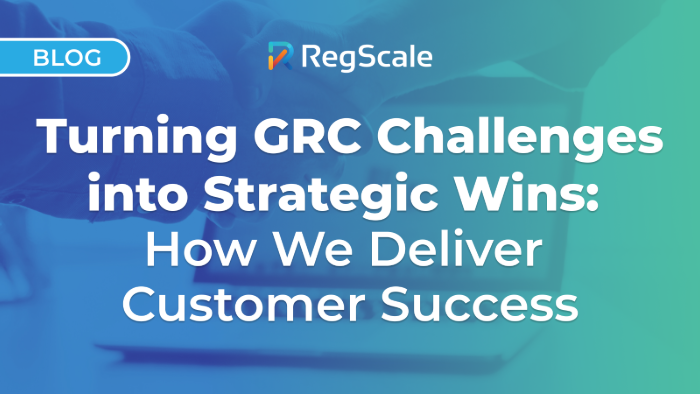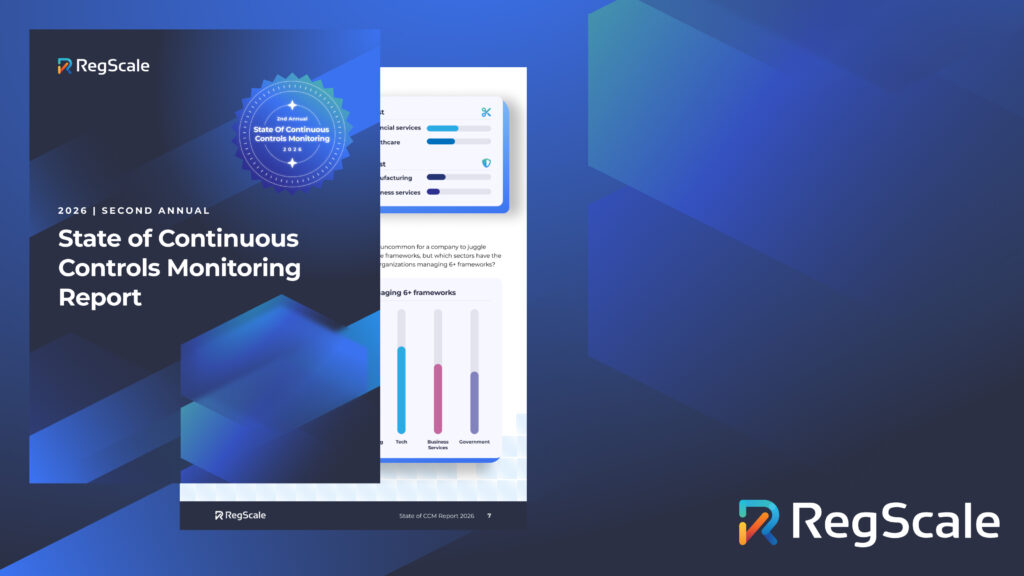Turning GRC Challenges into Strategic Wins: How We Deliver Customer Success

An energy and environmental contractor needing to transform their manual compliance process and achieve an always audit-ready state.
A government agency needing to implement an automated compliance model and speed up its adoption of NIST 800-53 Rev 5.
A nonprofit government services organization needing to streamline their cumbersome procurement processes for adopting new tools and solutions.
A military agency needing to automate its six RMF stages and establish rapid ATO, leading to 200,000% faster onboarding than in any other GovCloud environment.
These are just a few of the RegScale customers that have recently transformed their GRC programs with our Continuous Controls Monitoring platform. Their stories represent more than individual successes; they’re a testament to how effectively the right solution can tackle complex GRC challenges.
And let’s be honest — those challenges are only growing. As RegScale’s Director of Expert Services, I’ve seen firsthand how difficult it can be for organizations to turn their manual, outdated processes into streamlined, automated workflows in the face of ever-evolving regulatory requirements. That’s why we’ve devoted so much time to building a dedicated team that can help our customers tackle these challenges and achieve success with our platform.
How Our Team Delivers Customer Success & Services
When it comes to customer success, we follow a hybrid model that aims to go above and beyond traditional support. In part, we’ve shaped our customer experience philosophy around Shane Anastasi’s book, The Seven Principles of Professional Services, and particularly two of the principles: “Always Know What Done Looks Like” and “Participate in the Collective Wisdom.”
First and foremost, we make sure we know what “done” means to each customer. Well before an organization officially becomes a customer, we’re diving deep to understand what they’re seeking to accomplish with our technology and what their business objectives are. This helps us create a shared vision of success that we then continuously revisit and refine throughout our journey together.
We also share knowledge widely across our hybrid customer success team. With technical experts, solution advisors, engineers, and customer success professionals, we’ve built a comprehensive ecosystem that can address every possible customer need.
Our Solution Advisors are platform and domain experts who offer years of cybersecurity and GRC experience. They map our solutions directly to each customer’s unique business processes, whether it’s navigating the complexities of a FedRAMP certification or working through a PCI compliance program.
From there, our Technical Solution Engineers take things a step further. From creating new functionality to developing custom integrations, managing our command-line interface, and executing custom development projects, they ensure our platform continues to evolve with our customers’ needs.
Take our residency program, which lets us supercharge our technical support for customers. Last year, for example, we had employees embedded with a national laboratory and the Navy. They weren’t just consultants; they became badged members of the customers’ teams, showing up in person weekly as an extension of their organization.
Lastly, our customer success team provides the glue that holds everything together. They’re constantly looking for ways to maximize platform utilization, introduce customers to new features, and provide post-implementation support that ensures our customers are getting maximum value.
The bottom line? We’re not just a vendor. We’re partners, advisors, and often an extension of our customers’ teams with the collective expertise to help them transform their GRC programs.
Common Threads: What Our Customers Are Navigating
As we work alongside our customers, we’ve seen certain patterns that highlight the complex landscape they’re navigating. Nowhere is this more evident than in the world of FedRAMP, where our customers are navigating a constantly shifting regulatory environment. Their primary goal is achieving and maintaining their Authority to Operate (ATO), which is no small feat.
The industry has been shaken up by the recent announcement of the FedRAMP 20x pilot program, which seeks to dramatically streamline the ATO process with tech industry input. But the legacy Rev5 process is sticking around for the time being, and so are the two critical challenges that our FedRAMP customers typically encounter:
First, there’s the challenge of documentation development, particularly around the System Security Plan (SSP) creation. We accelerate that process significantly, offering up to 40% faster timelines for customers.
Second, there’s continuous monitoring. Our customers need solutions that can maintain an always audit-ready state — so we help them build a proactive security posture that goes beyond periodic assessments, creating a real-time, adaptive approach to compliance and risk management.
So far, our approach has paid off. There’s the specialized cloud consulting firm that was struggling to ramp up its operations until we automated and streamlined their submission of FedRAMP packages, helping them increase top line revenue and enrich their advisory practices. Then there’s the IT services organization that was able to significantly streamline its FedRAMP compliance, enhance the quality and efficiency of its ATO packages, and rapidly scale its delivery of services with our help.
There’s even our own story, of how we used our platform to achieve FedRAMP High In Process with:
- 300% less time
- 50% less cost
- 40 days to implement all 410 controls in FedRAMP
By providing flexible, intelligent solutions that adapt to the stringent and ever-evolving FedRAMP requirements, we’re helping these organizations transform compliance from a burden into a strategic advantage.
Evolving with Our Customers
As we grow from a startup to a strategic partner, we’ve learned that customer success isn’t about having a perfect, pre-defined playbook — it’s about building that playbook in real-time, adapting as quickly as our customers’ needs change.
Our onboarding program has become one secret weapon. We’ve essentially “projectized” our customer engagements, creating a structured yet flexible approach that elevates the entire customer experience.
Central to this approach is our comprehensive scorecard health monitoring program: a robust framework that gives us a 360-degree view of customer success and allows us to stay ahead of potential challenges. This scorecard helps us ask critical questions about our customers’ success:
- Business outcomes: Are we delivering the specific results you set out to achieve?
- Customer sentiment: How are you feeling about our partnership, and what’s your true level of satisfaction?
- Services optimization: Are we helping you unlock the full potential of our offerings?
- Product usage: Is our platform growing with your organization, and are you getting maximum value from every feature?
- Support: Are we resolving your needs quickly and effectively?
This approach has helped us move from a reactive support approach into a more proactive partnership model — anticipating needs, driving value, and continuously evolving alongside our customers.
Looking Ahead: Continued Commitment to Customer Success
In the year and a half I’ve been with RegScale, I’ve watched our platform grow into a game-changing solution for the GRC industry. Watching our team innovate and seeing customers overcome complex operational challenges has been nothing short of inspiring.
As we look ahead, we’re not just developing a platform; we’re cultivating partnerships that drive meaningful change. We’re excited to see where our journey takes us next — and we hope you’ll consider coming along for the ride.
Ready to get started?
Choose the path that is right for you!
Skip the line
My organization doesn’t have GRC tools yet and I am ready to start automating my compliance with continuous monitoring pipelines now.
Supercharge
My organization already has legacy compliance software, but I want to automate many of the manual processes that feed it.
